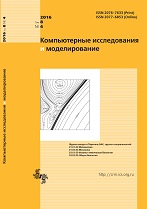|
MATHEMATICAL MODELING AND NUMERICAL SIMULATION
A new form of differential equations in modeling of the motion of a heavy solid
G. V. Gorra, E. K. Shchetininab
a Institute of Applied Mathematics and Mechanics,
7 R. Luxembourg st., Donetsk, 83114, Ukraine
b Kyiv National University of Trade and Economics,
19 Kyoto st., Kyiv, 02156, Ukraine
Abstract:
The different types of the reduced equations are known in the dynamics a heavy rigid body with a fixed point. Since the Euler-Poisson's equations admit the three first integrals, then for the first approach the obtaining new forms of equations are usually based on these integrals. The system of six scalar equations can be transformed to a third-order system with them. However, in indicated approach the reduced system will have a feature as in the form of radical expressions a relatively the components of the angular velocity vector. This fact prevents the effective the effective application of numerical and asymptotic methods of solutions research. In the second approach the different types of variables in a problem are used: Euler's angles, Hamilton's variables and other variables. In this approach the Euler-Poisson's equations are reduced to either the system of second-order differential equations, or the system for which the special methods are effective. In the article the method of finding the reduced system based on the introduction of an auxiliary variable is applied. This variable characterizes the mixed product of the angular momentum vector, the vector of vertical and the unit vector barycentric axis of the body. The system of four differential equations, two of which are linear differential equations was obtained. This system has no analog and does not contain the features that allows to apply to it the analytical and numerical methods. Received form of equations is applied for the analysis of a special class of solutions in the case when the center of mass of the body belongs to the barycentric axis. The variant in which the sum of the squares of the two components of the angular momentum vector with respect to not barycentric axes is constant. It is proved that this variant exists only in the Steklov's solution. The obtained form of Euler-Poisson's equations can be used to the investigation of the conditions of existence of other classes of solutions. Certain perspectives obtained equations consists a record of all solutions for which the center of mass is on barycentric axis in the variables of this article. It allows to carry out a classification solutions of Euler-Poisson's equations depending on the order of invariant relations. Since the equations system specified in the article has no singularities, it can be considered in computer modeling using numerical methods.
Keywords:
Euler-Poisson's equations, reduction, new form of the equations.
Received: 09.10.2016
Revised: 05.11.2016
Accepted: 09.11.2016
Citation:
G. V. Gorr, E. K. Shchetinina, “A new form of differential equations in modeling of the motion of a heavy solid”, Computer Research and Modeling, 8:6 (2016), 873–884
Linking options:
https://www.mathnet.ru/eng/crm34 https://www.mathnet.ru/eng/crm/v8/i6/p873
|

| Statistics & downloads: |
| Abstract page: | 212 | | Full-text PDF : | 106 | | References: | 29 |
|




 Contact us:
Contact us: Terms of Use
Terms of Use
 Registration to the website
Registration to the website Logotypes
Logotypes









 Citation in format
Citation in format 